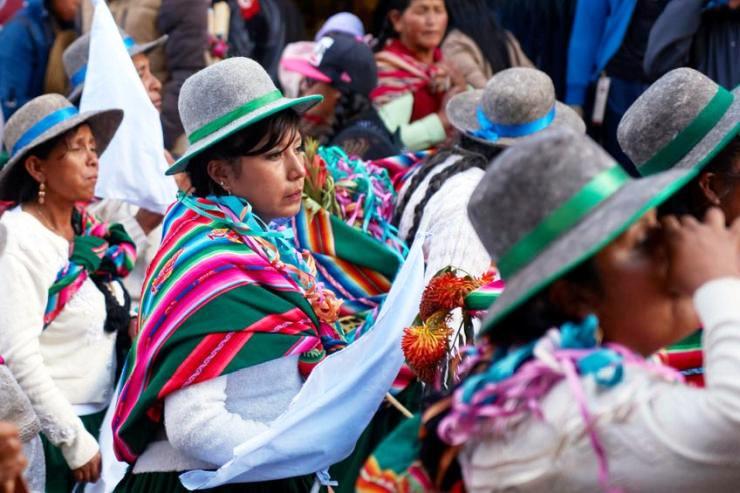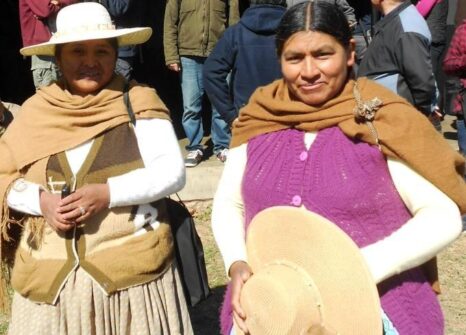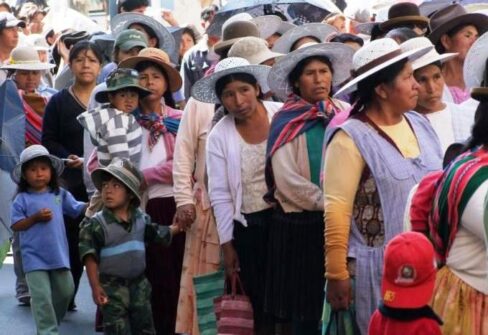Bolivia. The ‘Andean romeria’. A Festive Path among Songs and Prayers.

The pilgrimages of the various Andean communities are a combination of ancestral traditions and Christian spirituality.
The pilgrimage festivals take place between the months of September and October, which according to the Andean agricultural calendar are the months for sowing. The pilgrimage is prepared one year in advance when an organiser is selected for the celebrations of the following year. The organiser is responsible for the successful outcome of the event. He is supposed to be able to find the money necessary for all the expenses. He is supported in the preparation of the festival by the mayura, who must select the music and the musicians for the event. While the tata khumuri is responsible for the food transportation and the pack animals, the tata despensa is the food administrator, the mama cocinera is the one responsible for the preparation of food during the journey to the sanctuary and the journey back home.

The walking distance to the sanctuaries is between 40.50 and 60 km. Along the route, pilgrims can find specific places to rest, eat and pray before reaching their final destination.
On the day of departure, the tata khumuri, who leads the pack animals, walks ahead of the others, along with the tata despensa and the mama cocinera. The mayura and the tata pasante perform the ritual of departure, which marks the beginning of the journey. Pilgrims ch´allan, as a good omen for the journey, and entrust themselves to the Lord represented by an image or a cross covered with typical clothes. Once this ritual has been performed, pilgrims start their walk to the sanctuary, following the tata khumuri. They generally reach their destination in the afternoon and go to rest. The following day the tata pasante makes everything ready for the celebrations. The parish priest arrives and at half past ten everybody goes to the sanctuary accompanied by the jula julas, the musicians hired for the event and the mit’anis, young women waving flags of different colours. When this crowd reaches the door of the sanctuary, the musicians start to play the kuila (solemn music) on their knees, because they are in a sacred place.

The parish priest celebrates the Holy Mass and at the end of the celebration, pilgrims join a procession as a tribute to the Saint accompanied by the music played by the jula julas. Once the procession is over, all participants go back to their accommodation where the tata khumuri, the tata despensa and mama cocinera offer them food. Since it is a special day, two dishes are served, wheat soup and Jich´i with its kanka (potatoes cooked with chuño or mote corn and a piece of grilled meat). After the meal, the ch’alla ritual is performed, the tata pasante shares some chicha with the others, thanks God and asks for His blessing and protection. After the ritual the pilgrims go for a walk through the town. The next day they prepare their return home, they say goodbye from the ch`isiraya (place for farewell located at the exit of the town), and they start their walk back home feeling happy. During the journey they pray and when they are about to reach their community, they herald their arrival with an explosion from a stick of dynamite and then a second explosion follows to mean that they have arrived so that the second part of the celebrations can start. It is the moment of the pilgrims’ reunion with their relatives. The pilgrims have brought the jich`i and other foods they were offered during their pilgrimage to the sanctuary and share it with their families as a symbol of the blessing of the Lord. The following day, the celebrations continue, this time, with the entire community. It is the day during which the event organiser of the pilgrimage of the following year is selected.

The name of the new organiser is announced with an explosion of dynamite. The selected one is given all that is necessary to organise the event. He, in turn, begins to look for the assistants that will collaborate with him for the successful outcome of the next romeria festival. The next day he thanks all the staff that was involved in the event: the tata pasante, the tata mayura, the tata despensa, and mama cocinera and gives each of them, along with his wife, ch`alla and k`intu (offerings). In the afternoon between four and five, the sowing ritual, which concludes the day, is performed. The following day the dismantling of the altar, which had been set up for the event, marks the end of the pilgrimage festival. (Open Photo: ©jeremyrichards/123RF.COM)
Jhonny Mancilla Pérez



